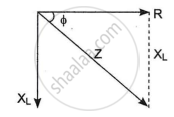Advertisements
Advertisements
प्रश्न
An alternating current I = 14 sin (100 πt) A passes through a series combination of a resistor of 30 Ω and an inductor of `(2/(5pi))` H. Taking `sqrt2` = 1.4 calculate the power factor of the circuit.
उत्तर
Given: I = 14 sin (100 πt) A, R = 30 Ω, L = `2/(5pi)`H
From here
ω = 100π
`X_L = omegaL` (inductive reactance)
= `100pi xx 2/(5pi) = 40Omega`
Impedance, Z = `sqrt(R^2 + X_L^2) = sqrt((30)^2 + (40)^2)`
Z = `sqrt(900 + 1600) = 50Omega`

Power factor = `cosphi`
phasor diagram for finding `phi`,
`cosphi = R/Z`
= `30/50`
`cosphi = 3/5`
Power factor = 0.6
APPEARS IN
संबंधित प्रश्न
When an AC source is connected to an ideal inductor show that the average power supplied by the source over a complete cycle is zero.
In a series LR circuit, XL = R and power factor of the circuit is P1. When capacitor with capacitance C such that XL = XC is put in series, the power factor becomes P2. Calculate P1/P2
Prove theoretically the relation between e.m.f. induced in a coil and rate of change of magnetic flux in electromagnetic induction.
Can you have an AC series circuit in which there is a phase difference of (a) 180° (b) 120° between the emf and the current?
The current in a discharging LR circuit is given by i = i0 e−t/τ , where τ is the time constant of the circuit. Calculate the rms current for the period t = 0 to t = τ.
In previous questions 3 and 4, what is the net power absorbed by each circuit over a complete cycle. Explain your answer.
Quality factor and power factor both have the dimensions of ______.
The average power dissipation in a pure capacitor in A.C circuit is
The power factor of an a.c circuit having resistance R and inductance L Connected in series to an a.c source of angular frequency co is.
In an AC. circuit, the current is :
i = `5 sin (100t - pi/2)` amp.
and the a.c. potentiol is:
V = 200 sin (100t) volt.
Then the power consumption is
